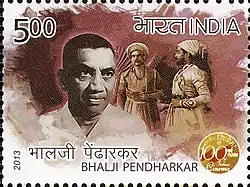Bhalji Pendharkar
Bhalji Pendharkar (3 May 1897 – 26 November 1994) was a film personality in India, and recipient of Dadasaheb Phalke Award, the most prestigious award in the field.
Bhalji Pendharkar | |
|---|---|
 Pendharkar on a 2013 stamp of India | |
| Born | Bhalji Pendharkar 3 May 1897 |
| Died | 26 November 1994 (aged 97) |
| Occupation | Director, Producer and Writer |
| Spouse(s) | Leela Chandragiri, Bakulabai Pendharkar, Saraswati Pendharkar, Savitri Pendharkar |
Early life and family
Born to Radhabai and her husband Dr Gopal Pendharkar in a Brahmin family,[1] Bhalji was related to quite a few film personalities in Indian film industry. A number of his close relations achieved fame in the Indian film industry. They include his elder brother Baburao Pendharkar, half-brother and actor-Director, Master Vinayak Karnataki, and maternal cousin V Shantaram.
Personal life
Bhalji had two wives. One of whom, Leela Chandragiri, acted and sang in Hindi and Marathi films in 1930s under the name Miss Leela. Leela-bai already had two children when she first met Bhalji. Bhalji adopted both of them, a boy (Jayasingh) and a girl. The girl later married novelist Ranjit Desai and she is better known as Madhavi Desai (died in 2013); she wrote the book 'Naacha Ga Ghumaa'. His second daughter's name was Saroj Chindarkar.
Bhalji's son with his first wife, Prabhakar Pendharkar (1933–2010), was associated with making of Do Aankhen Barah Haath in 1950s, wrote the book रारंगढांग, and was author-director of noteworthy documentaries. Bhalji named his studio Jayaprabha, combining in it the names of Leela's son Jayasingh (whom Bhalji had adopted) and his own son Prabhakar.
Film career
Bhalji started his career in the era of silent films. He was associated with Prabhat Film Company's earliest talkies, and also worked with other studios in hometown of Kolhapur. Later he acquired his own studio in form of Jayprabha Studio[2] and became a film producer and director. He also wrote lyrics for some film songs in Marathi. His more famous films are: Netaji Palkar, Thoratanchi Kamala, Chhatrapati Shivaji, Mohityanchi Manjula, Maratha Titutka Melvava, Sadhi Manse, Tambdi Maati. Hindi: Maharathi Karna, Valimi, Chhatrapati Shivaji.Ganimi Kawa
Bhalji was awarded the Dadasaheb Phalke Award in 1991 by the Indian Government.
List of successful movies directed
- 1925 Bajirao Mastani
- 1927 Vande Mataram Ashram
- 1931 Rani Rupmati
- 1932/II Shyam Sundar
- 1932/I Shyam Sundar
- 1934/I Akashwani
- 1934/II Akashwani
- 1934/II Partha Kumar
- 1934/I Partha Kumar
- 1935 Kalia Mardan
- 1935 Muraliwala
- 1936 Rukmani Kalyanam
- 1936 Savitri
- 1937 Kanhopatra
- 1938/II Raja Gopichand
- 1938/I Raja Gopichand
- 1939 Netaji Palkar
- 1940 Alakh Niranjan
- 1940 Gorakhnath
- 1941 Thoratanchi Kamala
- 1942 Bhakta Damaji
- 1942 Soonbai
- 1943 Bahirji Naik
- 1944 Maharathi Karna
- 1944 Swarna Bhoomi
- 1946/I Valmiki
- 1946 Sasurvaas
- 1949 Meeth Bhakar
- 1950 Mee Daru Sodli
- 1950 Shilanganache Sone
- 1952/I Chhatrapati Shivaji
- 1952/II Chhatrapati Shivaji
- 1953 Mazi Zameen
- 1954 Maharani Yesubai
- 1955 Yere Majhya Maglya
- 1956 Pavankhind
- 1957 Naikinicha Sazza
- 1959 Akashganga
- 1963 Mohityanchi Manjula
- 1964 Maratha Tituka Melvava
- 1965 Sadhi Manse
- 1969 Tambdi Maati
Films Written
- 1939 Netaji Palkar (writer)
- 1937 Kanhopatra
- 1934/I Akashwani (screenplay / story)
- 1934/II Akashwani (screenplay / story)
- 1932/I Shyam Sundar (screenplay / story)
- 1932/II Shyam Sundar (screenplay / story)
- 1927 Vande Mataram Ashram
- 1925 Bajirao Mastani
As producer
- 1939 Netaji Palkar
- 1927 Vande Mataram Ashram
As Actor
- 1924 Prithvi Vallabh
References
- Patil, Kavita. ""FILM INDUSTRY OF KOLHAPUR: A HISTORICAL SIGNIFICANCE." Proceedings of the Indian History Congress, vol. 64, 2003": 1197. JSTOR 44145547.
Baburao Painter was a carpenter, Bhalji and. Baburao Pendharkar were Brahmins
Cite journal requires|journal=(help) - "The autobiography of a film studio". Times of India. 25 September 2009.